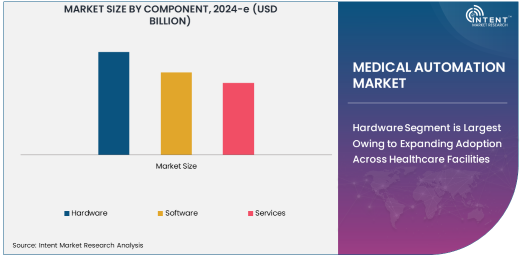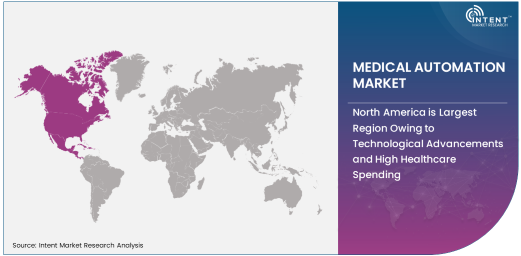As per Intent Market Research, the Medical Automation Market was valued at USD 63.2 Billion in 2024-e and will surpass USD 111.2 Billion by 2030; growing at a CAGR of 9.9% during 2025 - 2030.
The medical automation market is gaining significant traction, driven by the rising demand for precision, efficiency, and cost-effectiveness in healthcare delivery. Automation technologies are transforming healthcare practices, improving patient outcomes, and streamlining operational processes. Key segments in this market include components such as hardware, software, and services; diverse applications; and a variety of end-use industries.
Hardware Segment is Largest Owing to Expanding Adoption Across Healthcare Facilities
The hardware segment holds the largest market share, driven by its critical role in enabling automation across various medical applications. Hardware components such as automated machines, robots, and diagnostic instruments are integral to automation technologies in hospitals and laboratories.
Within the hardware category, robotic surgical systems and automated diagnostic devices are in high demand. Hospitals and clinics prioritize hardware investments to enhance accuracy, reduce human error, and improve workflow efficiency. Furthermore, the ongoing development of advanced technologies such as AI-enabled imaging devices and robotic surgical tools is expected to sustain the dominance of this segment over the forecast period.

Therapeutic Automation Segment is Fastest Growing Due to Increasing Use of Advanced Treatment Solutions
Therapeutic automation is the fastest-growing application segment, owing to advancements in robotic-assisted surgeries and automated drug delivery systems. This growth is fueled by the rising prevalence of chronic diseases requiring precise therapeutic interventions.
Automated therapeutic devices, such as insulin pumps, radiation therapy systems, and robotic surgery tools, are witnessing rapid adoption. The segment’s growth is also supported by technological innovation, which ensures enhanced patient safety and treatment efficacy. As healthcare providers continue to invest in cutting-edge therapeutic solutions, this segment is poised for robust expansion.
Hospitals and Clinics Segment is Largest Owing to Comprehensive Automation Adoption
Hospitals and clinics dominate the market among end-use industries, driven by their extensive integration of automation systems for diagnostics, monitoring, and therapeutic procedures. These facilities benefit from automation in managing high patient volumes and optimizing operational efficiency.
From robotic-assisted surgeries to automated diagnostic tools, hospitals leverage automation to improve patient outcomes and reduce treatment times. Additionally, the demand for automation in hospitals is bolstered by government initiatives promoting the adoption of advanced technologies to enhance healthcare infrastructure.
North America is Largest Region Owing to Technological Advancements and High Healthcare Spending
North America holds the largest share in the medical automation market, attributed to its well-established healthcare infrastructure, high adoption rates of advanced technologies, and significant investments in research and development. The U.S. and Canada lead the region, with strong support from government and private organizations to adopt automation technologies.
The presence of prominent medical technology companies and the increasing focus on precision medicine further contribute to the region's dominance. Additionally, favorable regulatory frameworks and funding for healthcare innovation provide an ideal environment for market growth.

Competitive Landscape and Key Players
The medical automation market is characterized by intense competition, with leading companies focusing on innovation, strategic collaborations, and mergers and acquisitions to expand their market presence. Key players include Medtronic, Siemens Healthineers, GE Healthcare, Philips Healthcare, and Intuitive Surgical.
These companies are actively investing in research and development to introduce cutting-edge products, such as AI-powered diagnostic tools and robotic surgical systems. Collaborations between healthcare providers and automation technology firms are also playing a vital role in driving market advancements. The competitive landscape is expected to evolve with emerging players bringing novel solutions to address the dynamic needs of the healthcare sector.
Recent Developments:
- Intuitive Surgical unveiled a new generation of its robotic-assisted surgery system, enhancing precision and flexibility.
- GE Healthcare launched advanced imaging automation software for faster and more accurate diagnostics.
- Siemens Healthineers partnered with a leading hospital chain to implement AI-driven automation solutions.
- Thermo Fisher Scientific expanded its automated laboratory equipment line with advanced liquid handling systems.
- Medtronic announced the acquisition of a healthtech startup specializing in AI-powered remote monitoring devices.
List of Leading Companies:
- Siemens Healthineers
- Medtronic plc
- Koninklijke Philips N.V.
- General Electric (GE) Healthcare
- Stryker Corporation
- Intuitive Surgical, Inc.
- Abbott Laboratories
- F. Hoffmann-La Roche Ltd.
- Danaher Corporation
- Becton, Dickinson and Company (BD)
- Boston Scientific Corporation
- Omnicell, Inc.
- CareFusion Corporation (BD)
- Thermo Fisher Scientific Inc.
- Zimmer Biomet Holdings, Inc.
Report Scope:
|
Report Features |
Description |
|
Market Size (2024-e) |
USD 63.2 Billion |
|
Forecasted Value (2030) |
USD 111.2 Billion |
|
CAGR (2025 – 2030) |
9.9% |
|
Base Year for Estimation |
2024-e |
|
Historic Year |
2023 |
|
Forecast Period |
2025 – 2030 |
|
Report Coverage |
Market Forecast, Market Dynamics, Competitive Landscape, Recent Developments |
|
Segments Covered |
Global Medical Automation Market by Component (Hardware, Software, Services), by Application (Diagnostic and Monitoring, Therapeutic Automation, Laboratory and Pharmacy Automation), by End-Use Industry (Hospitals and Clinics, Diagnostic Centers, Ambulatory Care Centers, Home Care) and By Region |
|
Regional Analysis |
North America (US, Canada, Mexico), Europe (Germany, France, UK, Italy, Spain, and Rest of Europe), Asia-Pacific (China, Japan, South Korea, Australia, India, and Rest of Asia-Pacific), Latin America (Brazil, Argentina, and Rest of Latin America), Middle East & Africa (Saudi Arabia, UAE, Rest of Middle East & Africa) |
|
Major Companies |
Siemens Healthineers, Medtronic plc, Koninklijke Philips N.V., General Electric (GE) Healthcare, Stryker Corporation, Intuitive Surgical, Inc., F. Hoffmann-La Roche Ltd., Danaher Corporation, Becton, Dickinson and Company (BD), Boston Scientific Corporation, Omnicell, Inc., CareFusion Corporation (BD), Zimmer Biomet Holdings, Inc. |
|
Customization Scope |
Customization for segments, region/country-level will be provided. Moreover, additional customization can be done based on the requirements |
|
1. Introduction |
|
1.1. Market Definition |
|
1.2. Scope of the Study |
|
1.3. Research Assumptions |
|
1.4. Study Limitations |
|
2. Research Methodology |
|
2.1. Research Approach |
|
2.1.1. Top-Down Method |
|
2.1.2. Bottom-Up Method |
|
2.1.3. Factor Impact Analysis |
|
2.2. Insights & Data Collection Process |
|
2.2.1. Secondary Research |
|
2.2.2. Primary Research |
|
2.3. Data Mining Process |
|
2.3.1. Data Analysis |
|
2.3.2. Data Validation and Revalidation |
|
2.3.3. Data Triangulation |
|
3. Executive Summary |
|
3.1. Major Markets & Segments |
|
3.2. Highest Growing Regions and Respective Countries |
|
3.3. Impact of Growth Drivers & Inhibitors |
|
3.4. Regulatory Overview by Country |
|
4. Medical Automation Market, by Component (Market Size & Forecast: USD Million, 2023 – 2030) |
|
4.1. Hardware |
|
4.2. Software |
|
4.3. Services |
|
5. Medical Automation Market, by Application (Market Size & Forecast: USD Million, 2023 – 2030) |
|
5.1. Diagnostic and Monitoring |
|
5.2. Therapeutic Automation |
|
5.3. Laboratory and Pharmacy Automation |
|
5.4. Others |
|
6. Medical Automation Market, by End-Use Industry (Market Size & Forecast: USD Million, 2023 – 2030) |
|
6.1. Hospitals and Clinics |
|
6.2. Diagnostic Centers |
|
6.3. Ambulatory Care Centers |
|
6.4. Home Care |
|
6.5. Others |
|
7. Regional Analysis (Market Size & Forecast: USD Million, 2023 – 2030) |
|
7.1. Regional Overview |
|
7.2. North America |
|
7.2.1. Regional Trends & Growth Drivers |
|
7.2.2. Barriers & Challenges |
|
7.2.3. Opportunities |
|
7.2.4. Factor Impact Analysis |
|
7.2.5. Technology Trends |
|
7.2.6. North America Medical Automation Market, by Component |
|
7.2.7. North America Medical Automation Market, by Application |
|
7.2.8. North America Medical Automation Market, by End-Use Industry |
|
7.2.9. By Country |
|
7.2.9.1. US |
|
7.2.9.1.1. US Medical Automation Market, by Component |
|
7.2.9.1.2. US Medical Automation Market, by Application |
|
7.2.9.1.3. US Medical Automation Market, by End-Use Industry |
|
7.2.9.2. Canada |
|
7.2.9.3. Mexico |
|
*Similar segmentation will be provided for each region and country |
|
7.3. Europe |
|
7.4. Asia-Pacific |
|
7.5. Latin America |
|
7.6. Middle East & Africa |
|
8. Competitive Landscape |
|
8.1. Overview of the Key Players |
|
8.2. Competitive Ecosystem |
|
8.2.1. Level of Fragmentation |
|
8.2.2. Market Consolidation |
|
8.2.3. Product Innovation |
|
8.3. Company Share Analysis |
|
8.4. Company Benchmarking Matrix |
|
8.4.1. Strategic Overview |
|
8.4.2. Product Innovations |
|
8.5. Start-up Ecosystem |
|
8.6. Strategic Competitive Insights/ Customer Imperatives |
|
8.7. ESG Matrix/ Sustainability Matrix |
|
8.8. Manufacturing Network |
|
8.8.1. Locations |
|
8.8.2. Supply Chain and Logistics |
|
8.8.3. Product Flexibility/Customization |
|
8.8.4. Digital Transformation and Connectivity |
|
8.8.5. Environmental and Regulatory Compliance |
|
8.9. Technology Readiness Level Matrix |
|
8.10. Technology Maturity Curve |
|
8.11. Buying Criteria |
|
9. Company Profiles |
|
9.1. Siemens Healthineers |
|
9.1.1. Company Overview |
|
9.1.2. Company Financials |
|
9.1.3. Product/Service Portfolio |
|
9.1.4. Recent Developments |
|
9.1.5. IMR Analysis |
|
*Similar information will be provided for other companies |
|
9.2. Medtronic plc |
|
9.3. Koninklijke Philips N.V. |
|
9.4. General Electric (GE) Healthcare |
|
9.5. Stryker Corporation |
|
9.6. Intuitive Surgical, Inc. |
|
9.7. Abbott Laboratories |
|
9.8. F. Hoffmann-La Roche Ltd. |
|
9.9. Danaher Corporation |
|
9.10. Becton, Dickinson and Company (BD) |
|
9.11. Boston Scientific Corporation |
|
9.12. Omnicell, Inc. |
|
9.13. CareFusion Corporation (BD) |
|
9.14. Thermo Fisher Scientific Inc. |
|
9.15. Zimmer Biomet Holdings, Inc. |
|
10. Appendix |
A comprehensive market research approach was employed to gather and analyze data on the Medical Automation Market. In the process, the analysis was also done to analyze the parent market and relevant adjacencies to measure the impact of them on the Medical Automation Market. The research methodology encompassed both secondary and primary research techniques, ensuring the accuracy and credibility of the findings.
.jpg)
Secondary Research
Secondary research involved a thorough review of pertinent industry reports, journals, articles, and publications. Additionally, annual reports, press releases, and investor presentations of industry players were scrutinized to gain insights into their market positioning and strategies.
Primary Research
Primary research involved conducting in-depth interviews with industry experts, stakeholders, and market participants across the E-Waste Management ecosystem. The primary research objectives included:
- Validating findings and assumptions derived from secondary research
- Gathering qualitative and quantitative data on market trends, drivers, and challenges
- Understanding the demand-side dynamics, encompassing end-users, component manufacturers, facility providers, and service providers
- Assessing the supply-side landscape, including technological advancements and recent developments
Market Size Assessment
A combination of top-down and bottom-up approaches was utilized to analyze the overall size of the Medical Automation Market. These methods were also employed to assess the size of various subsegments within the market. The market size assessment methodology encompassed the following steps:
- Identification of key industry players and relevant revenues through extensive secondary research
- Determination of the industry's supply chain and market size, in terms of value, through primary and secondary research processes
- Calculation of percentage shares, splits, and breakdowns using secondary sources and verification through primary sources
.jpg)
Data Triangulation
To ensure the accuracy and reliability of the market size, data triangulation was implemented. This involved cross-referencing data from various sources, including demand and supply side factors, market trends, and expert opinions. Additionally, top-down and bottom-up approaches were employed to validate the market size assessment.
NA
